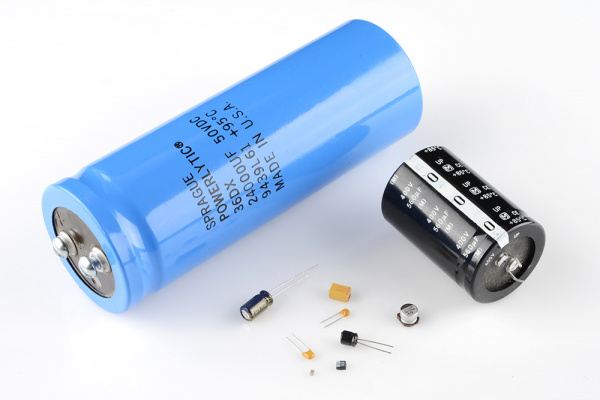Capacitors
Capacitors are components that are used to store an
electrical charge and are used in timer circuits. A capacitor may be used
with a resistor to produce a timer. Sometimes capacitors are used to smooth
a current in a circuit as they can prevent false triggering of other
components such as relays. When power is supplied to a circuit that includes
a capacitor - the capacitor charges up. When power is turned off the
capacitor discharges its electrical charge slowly.
It is a passive element designed to store energy in its electric field. Besides resistors, capacitors are the most common electrical components. Capacitors are used extensively in electronics, communications, computers and power systems.
A capacitor consists of two conducting plates separated by an insulator.

When a voltage source v is connected to the capacitor, as shown in the figure below,
It is a passive element designed to store energy in its electric field. Besides resistors, capacitors are the most common electrical components. Capacitors are used extensively in electronics, communications, computers and power systems.
A capacitor consists of two conducting plates separated by an insulator.

When a voltage source v is connected to the capacitor, as shown in the figure below,
 |
| A capacitor with applied voltage. |
the source deposits a positive charge q on one plate and a negative charge - q on the other. The capacitor is said to store the electric charge. The amount of charge stored, represented by q, is directly proportional to the applied voltage v so that
where C, the constant of proportionality, is known as the capacitance of the capacitor.
Capacitance is the ration of the charge on one plate pf a capacitor to the voltage difference between the two plates, measured in farads.
To obtain the current-voltage relationship of the capacitor, we take the derivative of both sides.
Capacitance is the ration of the charge on one plate pf a capacitor to the voltage difference between the two plates, measured in farads.
To obtain the current-voltage relationship of the capacitor, we take the derivative of both sides.
Differentiating both sides of equation.
The voltage-current relation of the capacitor can be obtained by integrating both sides of the equation above.
or
The energy stored in the capacitor is therefore,
We should note the following important properties of a capacitor:
1. A capacitor is an open circuit to DC.
2. The voltage on a capacitor cannot change abruptly.
3. The ideal capacitor does not dissipate energy.
4. A real, non-ideal capacitor has a parallel-model leakage resistance.
When capacitors are connected in series, the total capacitance is less
than any one of the series capacitors' individual capacitances. If two
or more capacitors are connected in series, the overall effect is that
of a single (equivalent) capacitor having the sum total of the plate
spacings of the individual capacitors. As we've just seen, an increase
in plate spacing, with all other factors unchanged, results in decreased
capacitance.

Thus, the total capacitance is less than any one of the individual capacitors' capacitances. The formula for calculating the series total capacitance is the same form as for calculating parallel resistances:

When capacitors are connected in parallel, the total capacitance is the sum of the individual capacitors' capacitances. If two or more capacitors are connected in parallel, the overall effect is that of a single equivalent capacitor having the sum total of the plate areas of the individual capacitors. As we've just seen, an increase in plate area, with all other factors unchanged, results in increased capacitance.

Thus, the total capacitance is more than any one of the individual capacitors' capacitances. The formula for calculating the parallel total capacitance is the same form as for calculating series resistances:

As you will no doubt notice, this is exactly opposite of the phenomenon exhibited by resistors. With resistors, series connections result in additive values while parallel connections result in diminished values. With capacitors, its the reverse: parallel connections result in additive values while series connections result in diminished values.
1. A capacitor is an open circuit to DC.
2. The voltage on a capacitor cannot change abruptly.
3. The ideal capacitor does not dissipate energy.
4. A real, non-ideal capacitor has a parallel-model leakage resistance.
SERIES AND PARALLEL CAPACITORS:
Thus, the total capacitance is less than any one of the individual capacitors' capacitances. The formula for calculating the series total capacitance is the same form as for calculating parallel resistances:
When capacitors are connected in parallel, the total capacitance is the sum of the individual capacitors' capacitances. If two or more capacitors are connected in parallel, the overall effect is that of a single equivalent capacitor having the sum total of the plate areas of the individual capacitors. As we've just seen, an increase in plate area, with all other factors unchanged, results in increased capacitance.
Thus, the total capacitance is more than any one of the individual capacitors' capacitances. The formula for calculating the parallel total capacitance is the same form as for calculating series resistances:
As you will no doubt notice, this is exactly opposite of the phenomenon exhibited by resistors. With resistors, series connections result in additive values while parallel connections result in diminished values. With capacitors, its the reverse: parallel connections result in additive values while series connections result in diminished values.






No comments:
Post a Comment